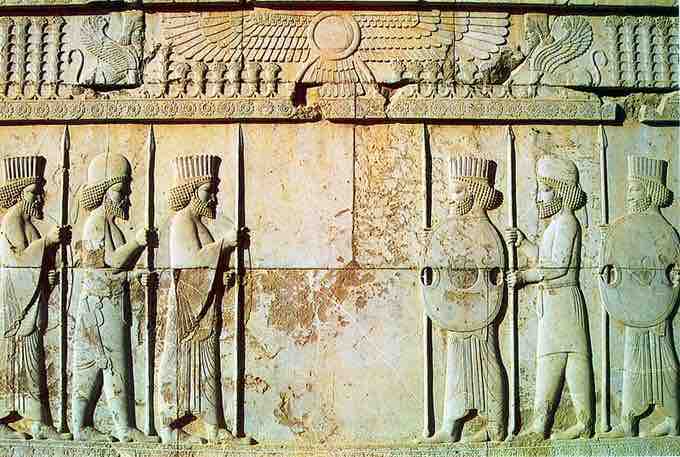Ancient Persian art developed and flourished under the Achaemenid Persian Empire (550–330 BCE), an Iranian empire in Western Asia, which eventually came to rule the ancient world from the Indus Valley in the east to Thrace and Macedon in the west.
Not only was the Achaemenid Dynasty militarily and politically influential, but it also left a long-lasting social and cultural legacy throughout its vast realms. Among its greatest cultural achievements was the development of Achaemenid art and architecture, which were intimately intertwined, reflected techniques and influences from the many corners of its huge empire, and synthesized different styles to develop a unique Persian style.

Decorative frieze from the palace of Darius the Great at Susa, ca. 510 BCE
Decorative panels from the terra-cotta griffins' frieze. The vivid colors were preserved, thanks to the ruins being buried underground and protected from the elements.
The Achaemenid Persians were particularly skilled at constructing complex frieze reliefs; crafting precious metals into jewelry, vessels, statuettes, and a myriad of other shapes; glazed brick masonry; decorating palaces; and creating gardens. They also constructed spectacular cities for governance and habitation, temples for worship and social gatherings, and mausoleums honoring fallen kings. The quintessential characteristic of Persian art and architecture is its eclectic nature, combining elements of Median, Assyrian, and Asiatic Greek styles.
Persepolis
The extraordinary architectural legacy of the Achaemenids is best seen in the ruins of the opulent city of Persepolis, the ceremonial capital of the Achaemenid Empire. Located about 70 kilometers northeast of the modern Iranian city of Shiraz, Persepolis is a wide, elevated complex 40 feet high, 100 feet wide, and a third of a mile long.

Persepolis
A panoramic view of its ruins.
It consists of multiple halls, corridors, a wide terrace, and a symmetrical double stairway providing access to the terrace, decorated with reliefs depicting scenes from nature and daily life. The largest hall in the complex is the audience hall of Apadana. This hypostyle hall has a total of 36 fluted columns with capitals sculpted into unique forms. It famously features the exquisite "Treasure Reliefs"—friezes emphasizing the divine presence and power of the king and depicting scenes from all across his vast empire and his army of Persian immortals.
The construction of Persepolis was initiated by Darius I (550–486 BCE), who also commissioned the construction of a grand palace in the city of Susa. The palace featured imperial art on an entirely unprecedented scale. Materials and artists were drawn from all corners of the empire to work on it. Styles, tastes, and motifs intermingled in a lavish expression of the hybrid art and architecture that was characteristic of the Persian Achaemenid style. This attention to diversity also appears in the reliefs from the hall of Apadana, in which leaders and dignitaries from various provinces appear in regional fashions beneath a frieze punctuated by male lamassus adopted from previous Mesopotamian cultures.

Relief from Apadana Hall, Persepolis
Features 5th century BC carving of Persian and Median soldiers in traditional costume. Note the subtle differences in the clothing and style of the soldiers on each side. The Medians are wearing rounded hats and boots.
The palace at Persepolis stood for nearly 200 years. In 330 BCE, the Macedonian emperor Alexander the Great (356–323 BCE) captured the city and allowed his troops to loot the palace. Inscriptions describe a great fire that engulfed "the palace" but do not specify which palace. Scholars believe these writings describe the destruction of Persepolis, based on the condition of the ruins found there. The fire likely started in the living quarters of the former emperor Xerxes I (518–465 BCE) and spread throughout the rest of the city. This event brought an end to the Achaemenid Empire and made Persepolis a Macedonian province.